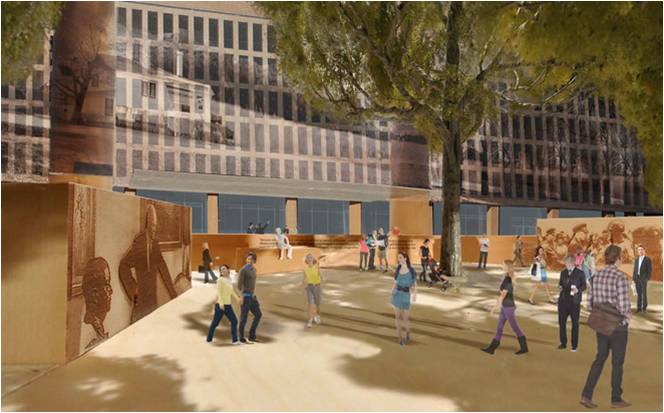This document is adapted from a letter from Thomas Luebke to the National Park Service dated 22 September 2011.

In September 2011, the Commission of Fine Arts approved a concept design for the proposed Dwight D. Eisenhower National Memorial, expressing great enthusiasm for the development of the design and for the artistic quality of the tapestry mockups as displayed on the memorial site.

The stone-clad columns would frame the axial vista to the Capitol along Maryland Avenue, which bisects the memorial site. (Image credit: Eisenhower Memorial Commission)
The Commission members expressed strong support for the revised configuration of the proposed memorial, including the 90-degree rotation of the two smaller tapestries and the reduction in the number of colossal columns. They endorsed the overall height and scale of the columns and tapestries, observing that these elements of the proposed memorial enable a welcome transformation of its site, currently a poorly defined urban space. They also commented positively on the more unified treatment of the area within the columns; however, they noted that both the landscape and the series of raised elements at the center of the composition will require further development to provide a focus for the memorial.

The memorial’s commemorative core would present sculptures and images of Eisenhower in bas-relief on stone slabs. (Image credit: Eisenhower Memorial Commission)
Regarding the development of the monumental tapestries, the Commission members expressed a strong preference for the technique using welded stainless-steel cable instead of the Jacquard-style woven alternative presented. They commented that the preferred method—derived from the hatched technique of engravers such as Albrecht Dürer—was highly sculptural when seen up close but appeared more photographic from a distance. While extremely supportive of this artistic approach, they raised concern about the literal translation of photography into art at this scale and encouraged further development of the conception of the image as a drawing. Reiterating their support for a landscape image for the memorial, they commented that the most powerful element of the image is the horizon line which, by extending across all three tapestries, would unify the sequence of panels.

The stainless steel tapestry panels feature landscape images evoking Eisenhower’s boyhood home in Kansas. Built up in layers of non-corrosive wire, the tapestries create different effects of transparency and opacity depending on lighting conditions. (Image credit: Eisenhower Memorial Commission)
The Commission members commended the project team for the sophistication of the design, noting that the proposed artistic treatment will transform the site and the context of adjacent federal buildings.
Note: This project has continued to be reviewed by the Commission of Fine Arts and the National Capital Planning Commission under the Commemorative Works Act. See the official action letter of the most recent CFA review.
